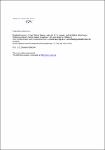Pork contaminated with Salmonella enterica serovar 4,[5],12:i:-, an emerging health risk for humans.
Hauser, Elisabeth
Tietze, Erhard
Helmuth, Reiner
Junker, Ernst
Blank, Kathrin
Prager, Rita
Rabsch, Wolfgang
Appel, Bernd
Fruth, Angelika
Malorny, Burkhard
Salmonella enterica subsp. enterica serovar 4,[5],12:i:- is a monophasic variant of S. enterica serovar Typhimurium (antigenic formula 4,[5],12:i:1,2). Worldwide, especially in several European countries and the United States, it has been reported among the 10 most frequently isolated serovars in pigs and humans. In the study reported here, 148 strains of the monophasic serovar isolated from pigs, pork, and humans in 2006 and 2007 in Germany were characterized by various phenotypic and genotypic methods. This characterization was done in order to investigate their clonality, the prevalence of identical subtypes in pigs, pork, and humans, and the genetic relatedness to other S. enterica serovar Typhimurium subtypes in respect to the pathogenic and resistance gene repertoire. Two major clonal lineages of the monophasic serovar were detected which can be differentiated by their phage types and pulsed-field gel electrophoresis (PFGE) profiles. Seventy percent of the strains tested belonged to definite phage type DT193, and those strains were mainly assigned to PFGE cluster B. Nineteen percent of the strains were typed to phage type DT120 and of these 86% belonged to PFGE cluster A. Sixty-five percent of the isolates of both lineages carried core multiresistance to ampicillin, streptomycin, tetracycline, and sulfamethoxazole encoded by the genes bla(TEM1-like), strA-strB, tet(B), and sul2. No correlation to the source of isolation was observed in either lineage. Microarray analysis of 61 S. enterica serovar 4,[5],12:i:- and 20 S. enterica serovar Typhimurium isolates tested determining the presence or absence of 102 representative pathogenicity genes in Salmonella revealed no differences except minor variations in single strains within and between the serovars, e.g., by presence of the virulence plasmid in four strains. Overall the study indicates that in Germany S. enterica serovar 4,[5],12:i:- strains isolated from pig, pork, and human are highly related, showing their transmission along the food chain. Since the pathogenicity gene repertoire is highly similar to that of S. enterica serovar Typhimurium, it is essential that interventions are introduced at the farm level in order to limit human infection.
Dateien zu dieser Publikation
Keine Lizenzangabe
Verwandte Publikationen
Anzeige der Publikationen mit ähnlichem Titel, Autor, Urheber und Thema.
-
2013-03-21ZeitschriftenartikelTyping of Salmonella enterica serovar Infantis isolates from 51 outbreaks in Germany between 1974 and 2009 by a novel phage-typing scheme Miller, Tatjana; Braun, Peggy; Fehlhaber, K.; Prager, Rita; Pfeifer, Yvonne; Rabsch, WolfgangWe developed a new phage-typing method and evaluated its application in combination with XbaI macrorestriction analysis by pulsed-field gel electrophoresis (PFGE) as a useful tool for the long-term epidemiology of Salmonella ...
-
2014-08-07ZeitschriftenartikelA multi-country outbreak of Salmonella Newport gastroenteritis in Europe associated with watermelon from Brazil, confirmed by whole genome sequencing: October 2011 to January 2012 Byrne, Lisa; Fisher, I.; Peters, T.; Mather, A.; Thomson, N.; Rosner, Bettina; Bernard, Helen; McKeown, P.; Cormican, M.; Cowden, J.; Aiyedun, V.; Lane, C.In November 2011, the presence of Salmonella Newport in a ready-to-eat watermelon slice was confirmed as part of a local food survey in England. In late December 2011, cases of S. Newport were reported in England, Wales, ...
-
2012-02-09ZeitschriftenartikelOutbreak of salmonellosis after a wedding party, Bavaria, Germany, summer 2010: the importance of implementing food safety concepts Wissmann, Beatrix von; Klinc, Christina; Schulze, R.; Wolf, A.; Schreiner, H.; Rabsch, Wolfgang; Prager, Rita; Hautmann, WolfgangAn outbreak of salmonellosis in the summer of 2010 after a wedding party in Bavaria, Germany, was investigated, to identify vehicles and source of the outbreak and any flaws in food safety procedures. A cohort study ...

